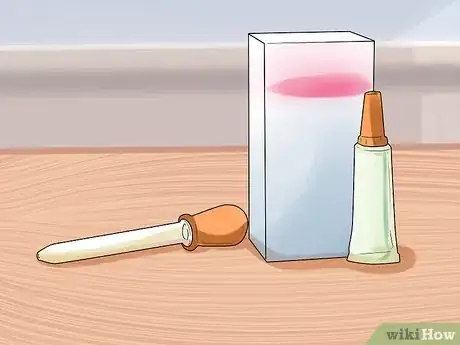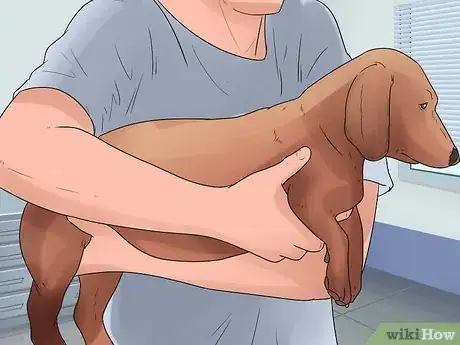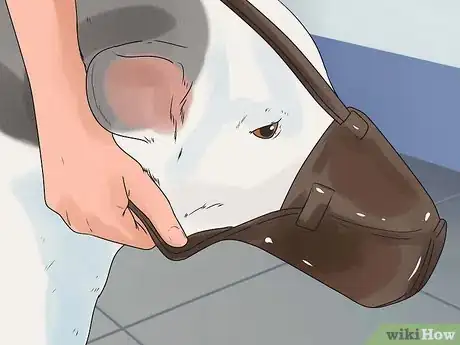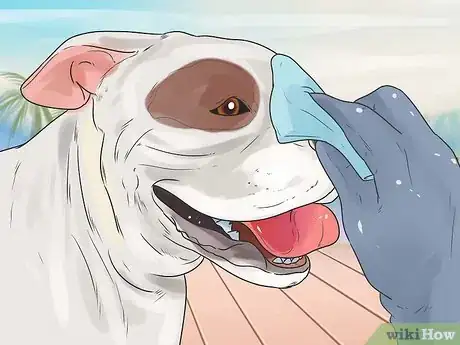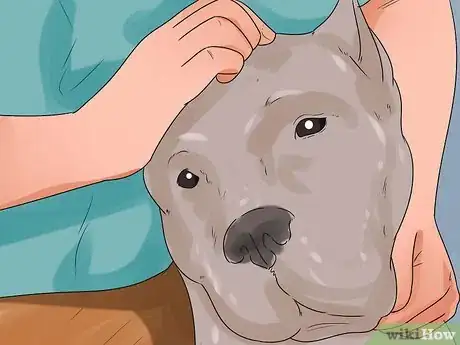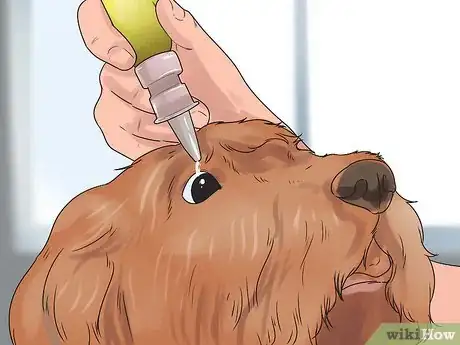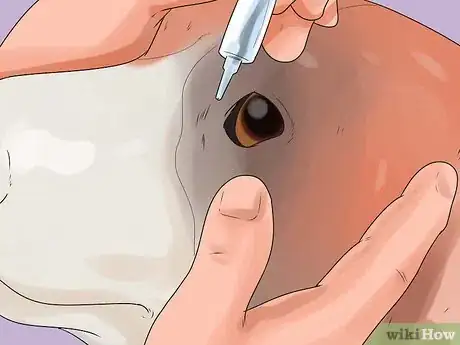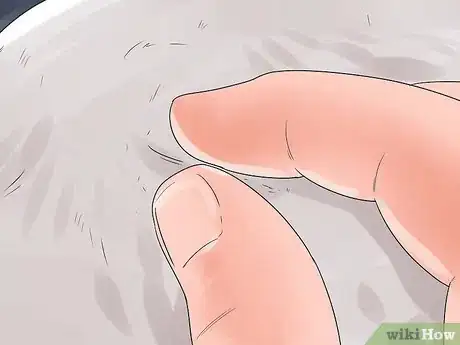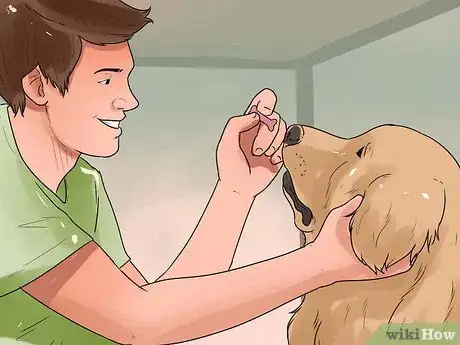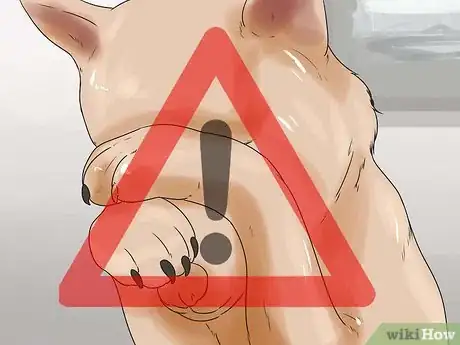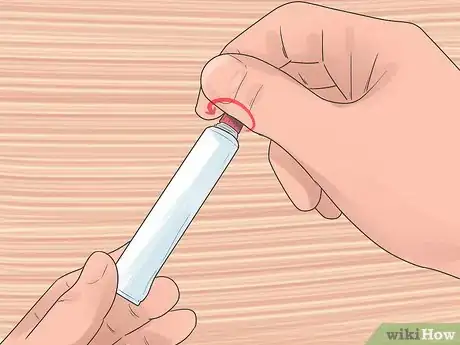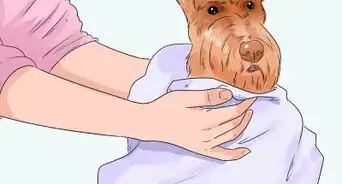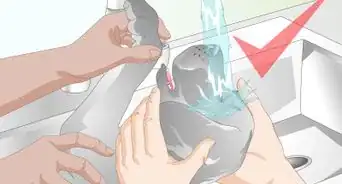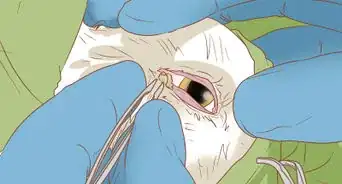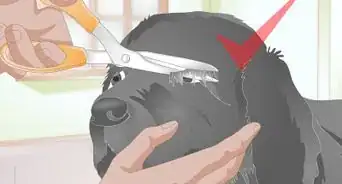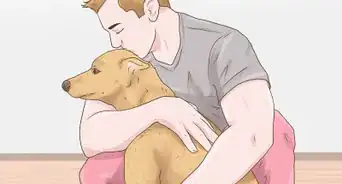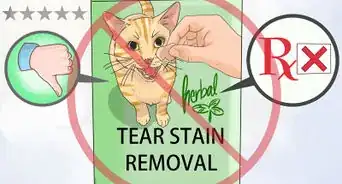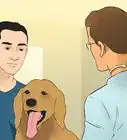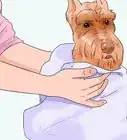This article was co-authored by Ray Spragley, DVM. Dr. Ray Spragley is a Doctor of Veterinary Medicine and the Owner/Founder of Zen Dog Veterinary Care PLLC in New York. With experience in multiple institutions and private practices, Dr. Spragley’s specializations and interests include non-surgical management of cranial cruciate ligament tears, Intervertebral Disk Disease(IVDD), and pain management in osteoarthritis. Dr. Spragley holds a BS in Biology from SUNY Albany and has a Doctor of Veterinary Medicine degree (DVM) from Ross University School of Veterinary Medicine. He is also a Certified Canine Rehabilitation Therapist (CCRT) through the Canine Rehab Institute as well as a Certified Veterinary Acupuncturist (CVA) through Chi University.
This article has been viewed 143,824 times.
Eye drops are usually used on a dog to heal infection, to help ulcers heal, and in some cases to treat dry eye. If your dog has one of these conditions, your veterinarian may prescribe topical eye drops or ointment.[1] In order to apply the medication properly, you’ll want to set everything up first and calm/restrain your dog before you actually treat your dog’s eyes.
Steps
Preparing to Administer Eyedrops
-
1Wash your hands before beginning. This is good practice to get used to. Since you are treating an area that is sensitive to dust, grim, and foreign bacteria, you don't want to add to endanger your dog's vision. Make sure you use anti-bacterial soap.
-
2Have the medicine ready. Whether you are using a drop or an ointment, you’ll want to have it open and close to you. Most likely, your dog won’t want to get the treatment and will struggle. You need to make this as speedy as possible.Advertisement
-
3Ask someone to help you. It really all depends on your dog. If your dog is lazy or peaceful, you might be able to apply the medicine yourself. If you think your dog will struggle, squirm, or even bite, you’ll need another person there to help you hold your dog.
-
4Hold your dog securely. If you are by yourself, it’s a good idea to apply the medication when your dog’s hindquarters are against a wall or a piece of furniture.[2] This will make it difficult for your pet to back away from you.
- If you have a helper, he can stand behind the dog or secure its hindquarters between his knees. With free hands, the helper can then stabilize your dog's head for you. If the dog is small enough, it might be easier to place it on a table.
-
5Consider alternative restraining techniques. If your dog’s legs are too strong to use the medicine while it is standing up, consider placing it on its side. Have the holder pin its legs to the ground. Similarly, if your dog tends to nip or bite when you apply medication to its eyes, you may need to get a muzzle. This will limit your dog’s ability to open its mouth. Muzzle your dog if you can't hold him in a relaxed position.
- Ideally, you shouldn't use either of these techniques. You don't want to stress your dog out more than you have to. If you create a pleasant experience for your dog, they'll be easier to manage in the future.
-
6Gently clean your dog's eyes. Before applying the medication, make sure that the eye area is clean. Place one hand on the side of your dog's jaw to support its head, and tilt its head upwards. Gently wipe away any discharge with a damp cotton wool ball or a tissue.
- Dispose of the items used to wipe your dog's eye promptly to avoid reinfection.
Applying the Medication
-
1Position the dog's head. Cradle your dog's head in your non-dominant hand and hold the bottle of drops with your dominant hand. With the thumb of the hand holding the head, gently pull up on its eyebrow to form a pouch.[3] This space behind the lower eyelid is the conjunctival sac, and it is a good place to apply eye medication. Rest the hand holding the medication on the pet's forehead, so if the dog jerks its head, your hand will move with it.[4]
-
2Apply eye drops. Without touching the tip of the bottle to the dog's eye (about 1/8” is a good distance), place the required number of drops into the conjunctival sac or on the eyeball.[5] [6]
- By putting the medicine in the conjunctival sac, it will spread around the eyeball easier without spilling out of the dog's eye. Try to give the drops a few seconds to disperse before letting the dog shake its head. As long as you actually get the drops in the eye, though, there's probably no need to worry if the dog does shake its head. Eye drops disperse rapidly.
-
3Apply eye ointment. The procedure is basically the same as administering eye drops. Restrain your dog’s head. Without touching the tip of the tube to the dog's eyeball, apply a ribbon of medication to the conjunctival sac. Gently close the dog's eye and massage the eyelid with your finger to disperse the medication across the eyeball.
- If your dog flinches and you are sure that none of the medication got into the eye, take a deep breath, wipe away the ointment, and try again. If you are patient and persistent, it will get easier.
-
4Gently massage your dog's eyelids. This will disperse the treatment. Do this lightly for as long as your dog will reasonably let you. Ideally, you would gently rub your dog's eyelid for 10 to 15 seconds to make sure that the medicine has fully spread across your dog's eye.
-
5Repeat the process. Follow your vet’s instructions. Some drops/ointments will need to be administered every two hours, some twice a day, and some once a day. The recommended frequency should be printed on the side of the bottle, if it’s a prescription drop/ointment.
- If you have been asked to treat both eyes even though only one eye appears infected, follow your vet's instructions. The second eye may need preemptive treatment to prevent the infection from gaining entry to that eye.
-
6Give your dog a treat when you finish. The more positive the experience you can make this for your pet, the easier it will be to medicate its eyes in the future. It is all about positive conditioning. Your dog will respond well.[7]
-
7Stop your dog from rubbing its eye. If your dog’s eyes were irritated before, the eye drops should help. Yet, in some cases, the eye drops or ointment might be a new source of irritation. Regardless, do your best to stop your dog from rubbing its eye. Your dog might use its paws to rub its eyes or it'll drag its heads on the carpet. Stay close to your dog and hold them if you need to while the medicine works its magic.
-
8Close and secure the medication. Most medicines need to be resealed after use to retain their potency. You’ve finished applying eye drops or ointments to your dog’s eyes, but the job isn’t over until the medicine is closed and placed in a safe place.
Expert Q&A
-
QuestionHow do you give an uncooperative dog eye drops?
 Ray Spragley, DVMDr. Ray Spragley is a Doctor of Veterinary Medicine and the Owner/Founder of Zen Dog Veterinary Care PLLC in New York. With experience in multiple institutions and private practices, Dr. Spragley’s specializations and interests include non-surgical management of cranial cruciate ligament tears, Intervertebral Disk Disease(IVDD), and pain management in osteoarthritis. Dr. Spragley holds a BS in Biology from SUNY Albany and has a Doctor of Veterinary Medicine degree (DVM) from Ross University School of Veterinary Medicine. He is also a Certified Canine Rehabilitation Therapist (CCRT) through the Canine Rehab Institute as well as a Certified Veterinary Acupuncturist (CVA) through Chi University.
Ray Spragley, DVMDr. Ray Spragley is a Doctor of Veterinary Medicine and the Owner/Founder of Zen Dog Veterinary Care PLLC in New York. With experience in multiple institutions and private practices, Dr. Spragley’s specializations and interests include non-surgical management of cranial cruciate ligament tears, Intervertebral Disk Disease(IVDD), and pain management in osteoarthritis. Dr. Spragley holds a BS in Biology from SUNY Albany and has a Doctor of Veterinary Medicine degree (DVM) from Ross University School of Veterinary Medicine. He is also a Certified Canine Rehabilitation Therapist (CCRT) through the Canine Rehab Institute as well as a Certified Veterinary Acupuncturist (CVA) through Chi University.
Veterinarian Hold your dog in a position where they can't back away from you. From there, lift the dog's muzzle up with one hand. Using the thumb of that same hand, pull their eyebrow (not eyelid) upward to help open the eye. Once the eye is exposed, use the other hand to insert the eye drops directly onto the eye.
Hold your dog in a position where they can't back away from you. From there, lift the dog's muzzle up with one hand. Using the thumb of that same hand, pull their eyebrow (not eyelid) upward to help open the eye. Once the eye is exposed, use the other hand to insert the eye drops directly onto the eye. -
QuestionCan you use normal eye drops for dogs with dry eyes?
 Pippa Elliott, MRCVSDr. Elliott, BVMS, MRCVS is a veterinarian with over 30 years of experience in veterinary surgery and companion animal practice. She graduated from the University of Glasgow in 1987 with a degree in veterinary medicine and surgery. She has worked at the same animal clinic in her hometown for over 20 years.
Pippa Elliott, MRCVSDr. Elliott, BVMS, MRCVS is a veterinarian with over 30 years of experience in veterinary surgery and companion animal practice. She graduated from the University of Glasgow in 1987 with a degree in veterinary medicine and surgery. She has worked at the same animal clinic in her hometown for over 20 years.
Veterinarian Most of the human eye drops used for dry eyes are bland and are designed to moisturize the eye, and can be applied into the canine eye. However, if you need to address a specific problem, such as a dog with the condition "Dry Eye", some drops are much more effective than others, especially those containing hyaluronic acid.
Most of the human eye drops used for dry eyes are bland and are designed to moisturize the eye, and can be applied into the canine eye. However, if you need to address a specific problem, such as a dog with the condition "Dry Eye", some drops are much more effective than others, especially those containing hyaluronic acid. -
QuestionWhat should I do if my dog's eyes sometimes get red and watery?
 Pippa Elliott, MRCVSDr. Elliott, BVMS, MRCVS is a veterinarian with over 30 years of experience in veterinary surgery and companion animal practice. She graduated from the University of Glasgow in 1987 with a degree in veterinary medicine and surgery. She has worked at the same animal clinic in her hometown for over 20 years.
Pippa Elliott, MRCVSDr. Elliott, BVMS, MRCVS is a veterinarian with over 30 years of experience in veterinary surgery and companion animal practice. She graduated from the University of Glasgow in 1987 with a degree in veterinary medicine and surgery. She has worked at the same animal clinic in her hometown for over 20 years.
Veterinarian Keep the eyes clean. Redness is a sign of inflammation, whilst wateriness can be a result of irritation, and so an allergy or dust irritation would be top of the list of possibilities. With this in mind review what you use around the dog, and stop using any aerosols such as air fresheners, deodorants, hairsprays, or perfume in the vicinity of the dog.
Keep the eyes clean. Redness is a sign of inflammation, whilst wateriness can be a result of irritation, and so an allergy or dust irritation would be top of the list of possibilities. With this in mind review what you use around the dog, and stop using any aerosols such as air fresheners, deodorants, hairsprays, or perfume in the vicinity of the dog.
Things You'll Need
- Eye drops or ointment
- Damp cotton wool ball or tissue
- Disposal bin for wiping items
References
- ↑ http://www.petmd.com/dog/general-health/evr_dg_eye_problems_in_dogs
- ↑ Ray Spragley, DVM. Veterinarian. Expert Interview. 19 August 2021.
- ↑ Ray Spragley, DVM. Veterinarian. Expert Interview. 19 August 2021.
- ↑ Debra Eldredge and Delbert G. Carlson, Dog Owner's Home Veterinary Handbook (Hoboken, N.J: Wiley, 2007), 174-175.
- ↑ Ray Spragley, DVM. Veterinarian. Expert Interview. 19 August 2021.
- ↑ Debra Eldredge and Delbert G. Carlson, Dog Owner's Home Veterinary Handbook (Hoboken, N.J: Wiley, 2007), 174-175.
- ↑ http://drsophiayin.com/blog/entry/training-a-dog-to-love-eye-drops-will-this-also-train-the-dog-to-chew
About This Article
To give eye drops to your dog, start by cradling its head in your non-dominant hand. Then, use your dominant hand to hold the bottle about 1/8 inch away from its eye, and apply the correct number of drops. Next, massage your dog’s eyelids to spread the medication, and give it a treat so it associates the drops with a positive experience. For tips on how to calm your dog before applying the eye drops, keep reading!

